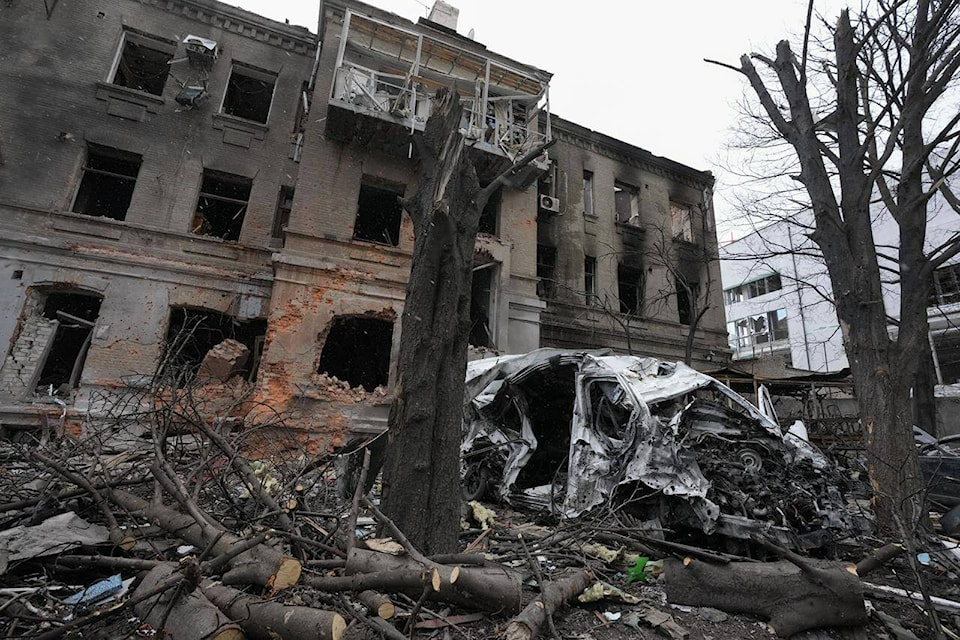The devastation in Ukraine by Russian armed forces brings back terrible memories for those who grew up in Britain around the time of the Second World War.
Mary Lowry, who was born about a year after the Battle of Britain when Germany launched large-scale air attacks on the country, said she was too young to remember much about the war, but does recall the destruction the bombs left behind.
Watching the newscasts of bombed-out buildings in Ukraine brings tears to her eyes.
“We’ve lived that,” said Mary fearing for the families and children sheltering from bombs.
“You see people carrying little babies around. It’s rough,” said the Red Deer resident.
Her family had to flee the city of Hull shortly before she was born. As a port city, it was a target for Germany.
Bombs were dropped on the docks at the bottom of their street, and one day their windows blew in and the back door flew off from the force of the blast, while her mom and sisters hid beneath the table.
Mary said her mom never took cover in air raid shelters.
“None of the wives would. Never really trusted them. She would sit under the stairs, the table, in the house.”
Bombs destroyed much of the city, including the fish and chips shop that her mom and grandma ran.
“Some of us could go back after the war, but we didn’t. There were no houses to go to.”
She said she understood how some Ukrainians won’t want to leave their country despite the danger because they might never go back if there’s nothing to go back to.
Mary’s family was moved three times before landing in the seaside community of Filey.
“I was named after a WVS (Women’s Voluntary Service) lady who helped move us into safety.”
Mary’s husband Peter, said luckily only a few bombs were dropped onto the small fishing town of Bridlington where he lived.
He said Germans used to fly to industrial areas to bomb factories. If it was too foggy they couldn’t see their targets, and they would unload the bombs on their way back.
“We had to shelter in the living room, but it wouldn’t have saved any of us,” said Peter about how they used bed frames to try and protect themselves.
As a young child, he remembers running to the windows whenever he heard a plane overhead, wanting to go outside, and his mom calling him back inside.
Rescue boats were stationed in his town to go out and collect downed pilots.
Mary said that while husbands and fathers were off fighting in the war, women were trying to take care of the children and keep them safe.
“You lost a lot, but you’ve got to keep going. You’ve got babies to feed.”
She said some families sent their children by ship to other countries to keep them safe, and Germans torpedoed one of those ships bound for Australia.
Related:
Local historian Michael Dawe said some children were sent to Canada, including the Red Deer area. But fewer children were sent away after those children tragically died on their way to Australia.
He said Canada regularly received news about the bombings in Britain.
“For a while during the Battle of Britain, it was pretty unclear who was going to win that campaign. You had this massive German air force and a very small British air force of fighter planes to try and stop them. The damage every night was tremendous all through particularly the southern part of the country.”
He said Germany tormented Britain’s civilian population.
“Towards the latter part of the war, they had what they called the buzz bombs. The motor would cut out and you couldn’t necessarily tell from the sound where it might hit. That was a real terrorization,” Dawe said.
“Hitler wanted England so bad. He thought he could walk in, but he didn’t,” Mary said with a smile.
Red Deer residents Denis and Anne Robinson, who were also children during the war, remembered buzz bombs, which were also called doodlebugs, because of the noise they made.
Anne said people didn’t always have time to get to a shelter with the unpredictable doodlebugs. Denis said near the end of the war, he heard the telltale engine of a doodlebug stop while he was working and ran towards a wall to protect himself from the blast that levelled a street of homes.
He said his village near the cliffs of Dover, which had a large Royal Marine barracks, was not bombed so much from the air, but shelled by artillery weapons.
Anne, who lived further inland, said her family would take cover in the shelter her father built when air raid sirens blew. Shelters were also built at schools.
“The German planes were coming in so low. As we ran, we could see the men in the planes. It was scary,” she said, remembering how her grandmother would hold onto her so she wouldn’t leave the family’s shelter.
Denis and Anne also recall getting gas masks.
“I was nine years old and we all had to go to the village hall and be fitted for them,” said Denis about the mask he would carry in a round tin.
Anne said she could understand how the fighting in Ukraine might bring back memories for those who survived the Second World War.
“I feel so sorry for those people. It’s just heart wrenching to see the pictures of those women carrying those kids, and trying to take enough stuff with them to keep them going. It’s an absolute tragedy,” she said about the reports on the struggles in Ukraine.
szielinski@reddeeradvocate.com
Like us on Facebook and follow us on Twitter
